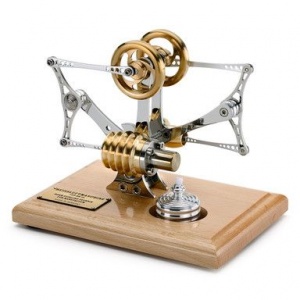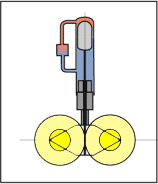| − | |desc=<div><div><div>0%</div><div>0%</div></div><div><h3>Open Source Two-Stroke Diesel Engine</h3><p>The goal is to develop a 50cc motor with a variable compression ratio & timing, this will allow the motor to run on a multitude of fuels.</p></div><br/><br/><div><div><div><h3>Become a Hackaday.io member</h3><p>Not a member? You should</p></div><div><div>Your Password</div><br/><div>Sign up</div></div></div><br/><br/><div>or use these profiles to log in</div></div></div><br/><div>Similar projects worth following</div><br/><br/><div><div><div>22.3k</div><br/><br/><h4>Team (4)</h4><br/><br/><h4>Related lists</h4><div><p>Starts April 25th - Ends May 30th / You’re an independent thinker, a troublemaker, and have no respect for the status quo.</p></div><h4>This project is submitted for</h4><br/><br/><p>This project was created on 03/31/2016 and last updated 3 years ago.</p></div><div><div>I am developing a single cylinder open source scalable diesel engine (based on the Junker Jumo 205 motor) to be used in a multitude of projects. This engine can be used to power moving sculptures, micro cars, mopeds, generators, pumps or anything that needs a power source. The open source approach allows me to develop a quality engine for everyone to enjoy at a minimal cost.</div><br/><div><p>I attempted this project last year but I greatly miscalculated how much time my new born daughter would take That being said, I now have some time available to dedicate to this project.</p><p>I thought of this project about six years ago while looking for a small engine that I could run off bio-fuel. To my surprise there were no light weight, compact, multi-fuel diesel engines available at a reasonable price. The idea is to develop a low cost open source two stroke diesel engine that can run off a variety of fuels. The initial design will be for a 50cc engine with the intent of being able to eventually scale to 125cc and 250cc. Such a motor could be used to power mopeds, small farm equipment, well drilling machines, pumps, generators, etc.</p><p>I have chosen the Junker Jumo engine design due to its piston configuration. On a standard diesel engine heavy cast iron cylinders and heads have to be manufactured in order to withstand the engine's compression. With the compression and fuel detonation taking place between two opposed pistons and in the center of the cylinder the walls can be thinner the further they are from the center of the cylinder. Both pistons will connect to the same crankshaft reducing the number of rotating parts. I have ran through about a dozen iterations in my head but up until now I haven't taken the time to model anything in CAD.</p><p>I have uploaded a few images of my concept. Please keep in mind that this is a quick (30 hour) and dirty (interference, exact calculations, etc. have not been taken into account) model to show the design intent. There is a lot of high level mathematical calculations and FEA (Finite Element Analysis) that will need to be done and I hope to start on those in the weeks to come.</p><h4>Requirements:</h4><ul><li>Simplicity (Two-Stroke)</li><li>Variable Compression Ratio (compressor/air pump)</li><li>Adjustable Timing (variable crankshaft)</li></ul><h4>Q and A</h4><p>Q: Why a two-stroke engine?</p><p>A: Two stroke engines are less complex than four-stroke Engines, produce more power per unit volume per stroke and are less expensive to produce.</p><p>Q: Aren't two-stroke engines bad for the environment?</p><p>A: Yes, traditional two-stroke engines produce more exhaust emissions than their comparable four-stroke counterparts. This is due to the intake and exhaust ports being simultaneously open and the addition of oil to the fuel for lubrication.</p><p>Q: How will this engine be better for the environment?</p><p>A: Fuel injection and its opposed pistons design are the key here. Each piston works somewhat like a valve, by adjusting the position of the piston in the cylinder the intake and exhaust ports can be timed for efficiency. Since the fuel will be injected after both ports are closed this should result in cleaner emissions.</p><p>Q: How will it run off various fuels?</p><p>A: Compression ratio and timing need to be controlled. By using a variable crankshaft and a compressor/air pump both the timing and compression ratio can be controlled using an ECU (engine control unit).</p><p>Q: How does a variable crankshaft work?</p><p>A: The crankshaft has a series of planetary gears associated with each piston. The connecting rods are connected to a planetary gear, by rotating the ring gears the timing of the piston(s) can be accurately controlled.</p><p>Q: Are there any other benefits to using a variable crankshaft?</p><p>A: Since each connecting rod is attached to a planet gear their movement is linear, therefore eliminating cylinder side load. Side load is the most common cause of rod bearing failure and cylinder wear.</p><p>Q: What are the disadvantages of a variable crankshaft?</p><p>A: A variable crankshaft is more complex than a standard crankshaft.</p><p>I would like to clarify that I don't see these motors being manufactured on the open planes of Africa as some have assumed. I see them being manufactured in shops (home, industrial, whatever) and being used in rural areas. I want to keep the design and simple as possible so when the day comes that repairs need to be made they can be done with minimal shop availability.</p></div><br/><br/><div>JUNKERS AIRCRAFT ENGINE JUMO 205 D SERIES 1 & 2 OPERATING INSTRUCTIONS AND MAINTENANCE INSTRUCTIONS</div><br/><br/><ul><li>• 04/21/2016 at 20:39 •<br/><div><p>With a 16+:1 compression ratio a compressor is not required to run diesel but would be useful for other fuels. Here are some concept renders or what the setup might look like.</p></div></li><br/><br/><li>• 04/21/2016 at 05:34 •<br/><div><p>Here are a few images of what four motors couples together would look like. <strong>ENJOY</strong></p></div></li><br/><br/><li>• 04/21/2016 at 05:31 •<br/><div><p>I have decided to move forward with a dual crankshaft configuration with static timing on the pistons in an effort to simplify the design. I have reduced the cylinder diameter to 30 mm and have increased the stroke to 33.25 mm per piston (overall stroke for both pistons is 66.5 mm). By increasing the stroke and going with a flat top piston design I have increased the static compression ratio to 23.17:1 which calculates to a 16.65:1 dynamic compression ratio from intake ports closing.</p><p>The dual crankshaft design reduces part the part count for major components to eight unique major components that need to be manufactured (crankshaft, connecting rod, piston, cylinder, sleeve, cranks case, timing belt cover & backing plate, timing gearbelt pulley. Since the motor is symmetrical the same components are used on both ends of the cylinder. The upper (right side of image) crankshaft has had the extension removed to allow for a cover plate.</p><p>As with my previous posts there is still a lot of engineering and analysis that need to go into this design. This is a rough model with some calculations taken into account but by no means is meant to represent a finished product. You will notice that the fuel injector port is missing, this is an example of some of the things that still need to be modeled. There is most likely some interference between the connecting rods and the sleeve. The connecting rods have not been optimized for weight, performance or clearance.</p><p>Thoughts:</p><ul><li>A compressor could be driven by the upper crankshaft to increase cylinder pressure and help with scavenging.</li><li>I would like to come up with a universal coupler for both ends of each crankshaft that would allow a symmetrical design. cogs, extensions, compressors, accessories, etc. could mate to the coupler. This would make the cylinder/crankcase assembly completely symmetrical when the timing belt and extension are not installed and would allow for joining two or more motors together with a universal adapter.</li><li>The sleeve has ten intake and ten exhaust ports spaced 36 degrees.</li><li>The cylinder has a runner for both the intake and exhaust that run 360 degrees.</li><li>I have designed a 0.0762 mm (0.003") interference between the sleeve and the aluminum cylinder. Liquid Nitrogen Shrink fitting will be used to install the sleeve.</li><li>A spring loaded belt retention will be used to assure the belt stays tight.</li></ul></div></li><br/><br/><li>• 04/11/2016 at 20:10 •<br/><div><p>As (tlidikay) and (Patrick) mentioned in the comments a chain drive connecting dual crankshafts might be a viable option. It would reduce reciprocating mass, reduce part count and might reduce weight while still allowing for adjustable timing on both pistons. Please feel free to share your thoughts, ideas, concerns, etc. Here are a few CAD renderings of a possible chain configuration.</p></div></li><br/><br/><li>• 04/11/2016 at 20:01 •<br/><div><p>Here is a simplification of the crankshaft concept that I uploaded yesterday. I have removed extra ring gears that were unnecessary. This multi piece crankshaft is constructed of seven individual crank sections and three ring gears. There would only be four part numbers used for the complete assembly.</p><ul><li>Planet gear/crank journal (green) - QTY REQ: 3</li><li>Double sided rod journal (middle grey) - QTY REQ: 2</li><li>Single sided rod journal (outer grey) - QTY REQ: 2</li><li>Ring Gear (pink) - QTY REQ: 3</li></ul></div></li><br/><br/><li>• 04/10/2016 at 21:34 •</li><br/><br/><li>• 04/07/2016 at 18:11 •<br/><div><p>By rotating the ring gear the planet gear' can be rotated around the rings axis allowing the piston timing to be adjusted while the motor is running. A servo or stepper motor connected to an ECU (Engine Control Unit) could be used to automatically adjust the piston timing. This would allow the intake and exhaust ports to be open or closed for any given period of time by simultaneously adjusting the ring gear while the crankshaft revolves. We can consider it almost like infinitely variable valve timing (I know it's not infinitely but it sounds good).</p><p>Dual helical gears are located on both sides of each connecting rod. There will be one right handed and one left handed helices, this balances the axial thrust in both the direction by developing opposite thrust reactions and thus balancing the axial force. It also allows for higher power transmission capacities.</p></div></li><br/><br/><li>• 04/04/2016 at 19:18 •<br/><div><p>Compression Ratio (CR): The ratio of the cylinder volume compared to the combustion chamber volume.</p><p>Static Compression Ratio (SCR): The ratio derived from the swept volume of the cylinder using the full crank stroke (BDC to TDC).</p><p>Dynamic Compression Ratio (DCR): The ratio calculated using the position of the piston at intake valve closing rather than BDC of the crank stroke to determine the sweep volume of the cylinder.</p><p>For now I am only going to calculate the Static Compression Ratio.</p></div></li></ul><br/><br/><h4>Enjoy this project?</h4>Share<br/><h4>Discussions</h4><br/><br/><div><div>wrote<p>Are you sure? </p></div><br/><div>wrote<p>Are you sure? </p></div><br/><div>wrote<p>Are you sure? </p></div><br/><div>wrote<p>Are you sure? </p></div><br/><div>wrote<p>Are you sure? </p></div><br/><div>wrote<p>Are you sure? </p></div><br/><div>wrote<p>Are you sure? </p></div><br/><div>wrote<p>Are you sure? </p></div><br/><div>wrote<p>Are you sure? </p></div><br/><div>wrote<p>Are you sure? </p></div><br/><div>wrote<p>Are you sure? </p></div><br/><div>wrote<p>Are you sure? </p></div><br/><div>wrote<p>Are you sure? </p></div><br/><div>wrote<p>Are you sure? </p></div><br/><div>wrote<p>Are you sure? </p></div><br/><div>wrote<p>Are you sure? </p></div><br/><div>wrote<p>Are you sure? </p></div><br/><div>wrote<p>Are you sure? </p></div><br/><div>wrote<p>Are you sure? </p></div><br/><div>wrote<p>Are you sure? </p></div></div></div></div><div><h4>Similar Projects</h4><br/><br/><div><div>Project Owner Contributor</div><br/><br/><div>Project Owner Contributor</div><br/><br/><div>Project Owner Contributor</div></div></div><br/><br/><div><h3>Does this project spark your interest?</h3><p>to follow this project and never miss any updates</p></div><br/><div><div><p>By using our website and services, you expressly agree to the placement of our performance, functionality, and advertising cookies.</p></div><div>Ok, I agree</div></div><br/><br/><div><h4>Report project as inappropriate</h4><p>You are about to report the project "<b>Open Source Two-Stroke Diesel Engine</b>", please tell us the reason.</p></div><br/><br/><div><h4>Send message</h4><p>Your application has been submitted.</p></div><br/><div><h4>Remove Member</h4><p>Are you sure you want to remove yourself as a member for this project?</p><p>Project owner will be notified upon removal.</p></div> | + | |typeproject=TUBerlin |


